Page outline
- Introduction
- Chlorophyll, photoexcitation, and, photosystems
- Non-Cyclic Electron Flow
- Quiz: Photoexcitation, Photosystems, and Non-cyclic Electron Flow
- The Z Scheme
- Quiz: The Z Scheme
- Cyclic electron flow
- Quiz: Cyclic Electron Flow
- Cumulative Quiz: The Light Reactions
1. Introduction
In the last tutorial we talked about how during photosynthesis, a chloroplast takes light energy, converts it into an electrical current, and then uses the energy from that electrical current to create chemical energy in the form of NADPH and ATP. Now it’s time to embody these transformations in the structure of the thylakoid membrane (shown below).

In the diagram above, “m” shows an entire chloroplast, “n” shows a stack of three thylakoids, and “o” shows the thylakoid membrane. Number “1” indicates the stroma (the fluid between the thylakoids and the inner chloroplast membrane). Number “2” indicates the thylakoid space, the enclosed, fluid-filled compartment inside the thylakoid.
The energy transformations that occur during the light reactions stem from events that occur along the thylakoid membrane. “A” and “D” show light energy, which drives the entire process. The electrical current that this light energy is transformed into is indicated by the series of orange arrows that starts below “l” and continues through “b,” “e,” and “f” (and some other unlabeled segments). The transformation of the energy in this electrical current into chemical bond energy is shown by the formation of NADPH at “g” and ATP at “h.”
The goal of what follows is for you to be able to explain these transformations, as they occur in the diagram shown above. Let’s go.
2. Chlorophyll, photoexcitation, and photosystems
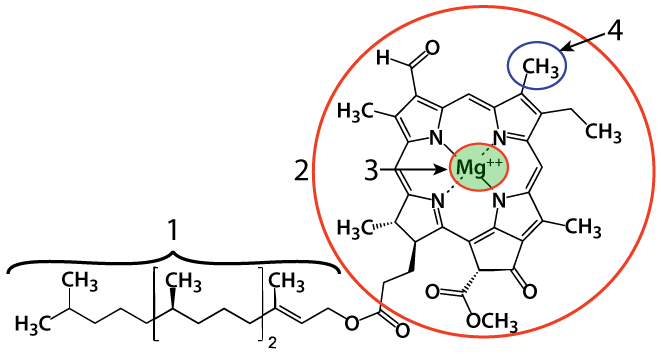 Chlorophyll is found embedded within the thylakoid membrane. If you look at the diagrams above, you can find chlorophyll represented by the green circles in the protein complexes surrounding the orange arrows at “l” and “e.” These protein complexes are labeled as “photosystem 1” and “photosystem 2,” and I’ll explain how they work below.
Chlorophyll is found embedded within the thylakoid membrane. If you look at the diagrams above, you can find chlorophyll represented by the green circles in the protein complexes surrounding the orange arrows at “l” and “e.” These protein complexes are labeled as “photosystem 1” and “photosystem 2,” and I’ll explain how they work below.
Chlorophyll, as we’ve seen in the previous tutorial, has a central porphyrin ring (everything within the red circle at “2”), with a magnesium ion (number “3”) positioned in the center.
This molecular structure allows for photoexcitation. When isolated chlorophyll (shown at “3,” below) absorbs light energy (“2”), its electrons (“4”) can get boosted up to a higher energy level. Once there, they fall back down (“5”), emitting heat (“6”) and light (“7”). What does “isolated chlorophyll” mean? It means that this is what happens when chlorophyll is artificially extracted from a chloroplast, dissolved in alcohol, and exposed to ultraviolet light. Click here to watch a cool video (not one of mine) showing photoexcitation in a chlorophyll solution.
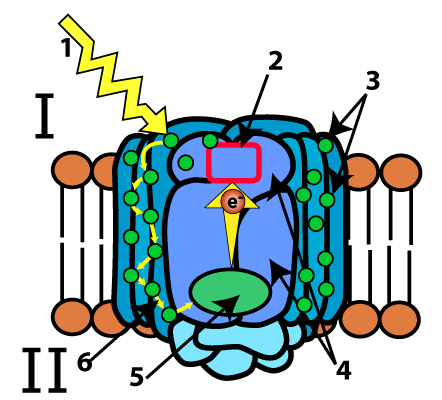 In a chloroplast, chlorophyll molecules are not isolated but are organized into photosystems, which are embedded in the membranes of the thylakoid sacs. A single photosystem is shown at the right, and you can check the diagram at the top of this page to see photosystems within the context of the thylakoid membrane (surrounding the letters “l” and “e” above). Within a photosystem, light (“1”) strikes any one of the many chlorophyll molecules (any of the green circles, such as those at “3”). These chlorophylls are collectively referred to as an antenna complex. If you’re too young to have an image of a television antenna, then try imagining a satellite dish receiver. Just like the antenna complex in a photosystem, both of these devices collect diffuse energy and then transmit it to another part of a system.
In a chloroplast, chlorophyll molecules are not isolated but are organized into photosystems, which are embedded in the membranes of the thylakoid sacs. A single photosystem is shown at the right, and you can check the diagram at the top of this page to see photosystems within the context of the thylakoid membrane (surrounding the letters “l” and “e” above). Within a photosystem, light (“1”) strikes any one of the many chlorophyll molecules (any of the green circles, such as those at “3”). These chlorophylls are collectively referred to as an antenna complex. If you’re too young to have an image of a television antenna, then try imagining a satellite dish receiver. Just like the antenna complex in a photosystem, both of these devices collect diffuse energy and then transmit it to another part of a system.
The chlorophylls in an antenna complex act as a kind of net. If any one of the chlorophylls captures a photon’s energy, that energy can be passed from one chlorophyll to the next. This energy transfer is not by an electrical current: it’s by a process called resonance energy transfer (which you can read about on Wikipedia).
At some point, the energy arrives at a reaction center (“4”). In the reaction center, a chlorophyll molecule (at “5”) is positioned across from a protein complex called a primary electron acceptor (at “2”). When electrons from the chlorophyll at “5” are boosted to a higher energy level (as shown by the yellow arrow between “5” and “2”), the primary electron acceptor snatches them up. This chemically reduces the primary electron acceptor (because it has gained electrons) and oxidizes the chlorophyll (because it has lost electrons). This loss of electrons, caused by photoexcitation, is the driving force behind the electrical current that’s the basis for transforming light energy into chemical energy during the light reactions.
3. In Noncyclic Electron Flow, chloroplasts synthesize both ATP and NADPH
In the diagram below, you can see how within a thylakoid membrane, two photosystems are organized in sequence. If, in your studies of biology you’ve become accustomed to thinking of structure-function relationships, then note that this is the structure that carries out the function of converting light energy into chemical energy. Also, note that there are many of these conjoined photosystems in the membrane of a thylakoid (and not just two in each thylakoid). These photosystems have numbers, and the numbers relate to the order of their discovery in the 1950s and 1960s. As electrons flow through this system, they flow first through Photosystem II and then through Photosystem I. If you find the fact that photosystem II comes before photosystem I to be somewhat cognitively dissonant, you’re not the first biology student to have had that feeling. Sorry!
Much of what happens during the light reactions occurs simultaneously, but to make it understandable, I’m going to present what happens in a linear order. We’ll begin with “a,” and move forward from there. Also note that in my biology curriculum, I teach photosynthesis after I’ve taught about oxidative phosphorylation in mitochondria, which use similar mechanisms to create ATP and NADH (NADPH’s close relative). You might want to review that tutorial before proceeding.
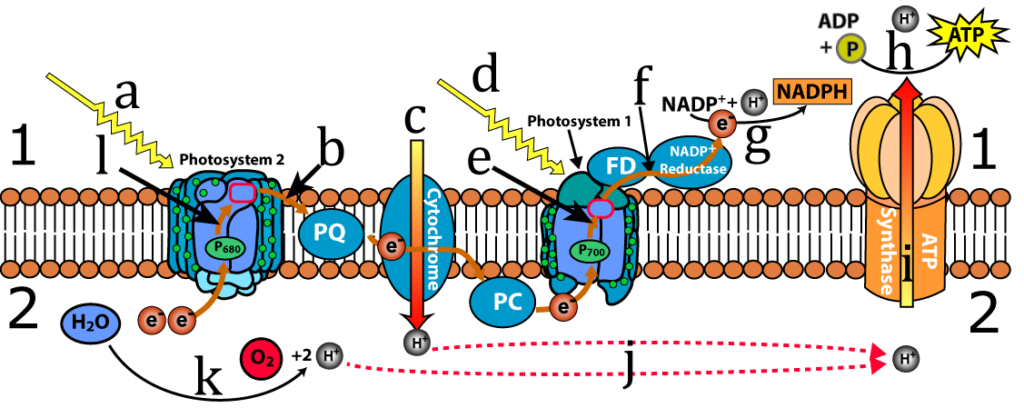
- “A” shows a photon striking the antenna complex of Photosystem 2. As described above, the photon will excite electrons in chlorophyll, and the energy will bounce around until it reaches Photosystem 2’s reaction center. This reaction center is called p680, named for the wavelength of light that best stimulates that photosystem. Light at 680 nanometers is in the red part of the spectrum.
- Electrons will jump from p680 to a primary electron acceptor, which will pass them to an electron transport chain (indicated by the orange arrow at “b”). The electron transport chain (ETC) is a series of enzymes embedded in the thylakoid membrane, each more electronegative than the previous one. You can think of electronegativity as the “capacity to grab electrons.” Because of this increasing electronegativity, electrons flow from the primary electron acceptor to PQ (which stands for “plastoquinone”), to cytochromes, to PC (which stands for “plastocyanin”).
- During each electron handoff, the electrons release a bit of the energy initially absorbed from the photon that hit Photosystem 2’s antenna complex. That released energy is used to perform some work, which is shown at “c”: pumping protons from the stroma to the thylakoid space. Why? As we’ll see (and as you already know if you’ve already studied ATP synthesis in the oxidative phosphorylation stage of cellular respiration), pumping protons into a cellular compartment is the basis of ATP synthesis. Note that this is an active transport process: protons are getting pumped from where they’re in low concentration (in the stroma) to where they’re in high concentration (in the thylakoid space). We’ll return to this process in a moment.
- Loss of electrons is oxidation, and p680 is now in an oxidized state. To replace these electrons, an oxygen-evolving complex (also known as a water-splitting complex) that is built into Photosystem 2 grabs electrons from a water molecule. The electrons flow to p680. Without these electrons, the water dissociates into protons and oxygen. All of this is shown at “k.” At “j” you can see these protons accumulating in the thylakoid space (region “2”), joining the protons that were pumped there by the electron transport chain at “c.”
- Now find “e.” Look down a bit, and locate the electron just to the right of PC. This electron was initially boosted by Photosystem 2. It was passed along the electron transport chain, and its energy was used for proton pumping. Depleted of energy, it arrives at Photosystem I.
- Photosystem 1 is also being struck by photons (letter “d”), which excite the electrons in its antenna complex, which bounce around until arriving at Photosystem I’s reaction center, p700. At p700, energized electrons are grabbed by the primary electron acceptor of Photosystem I, which sends them to a second electron transport chain (shown at “f”).
- The electron transport chain that follows Photosystem I (again, “f”) sends its electrons toward the mobile electron carrier NADP+. An enzyme called NADP+ reductase uses these electrons to reduce NADP+ to NADPH (shown at “g”). Hooray! We’re finally seeing a production of one of the products of the light reactions. Light energy has been converted into electron flow, which has been converted into the chemical energy of NADPH. But we’re not done yet…
- In step “6,” p700 was oxidized. To replace its lost electrons, it accepts the electron that has been flowing in its direction from Photosystem II, which ultimately can be traced back to a water molecule.
- Steps “c” and “k” have been causing protons to accumulate in the thylakoid space. The result is a two-fold gradient. First, it’s a diffusion gradient, with a thousand times more protons inside the thylakoid space than in the stroma (the fluid outside of the thylakoids). Just based on simple diffusion, these protons will “want” to diffuse from where they’re more concentrated to where they’re less concentrated. Second, it’s an electrochemical gradient. These protons are all positively charged. Like charges repel, and these protons “want” to get away from one another.
- This proton concentration gradient is a source of potential energy, and the chloroplast makes use of it at letter “i” (on the right side of the diagram). The channel at “i” goes through ATP synthase, the enzyme that uses the kinetic energy of diffusing protons to make ADP and Pi into ATP (which you can see happening at “h”). In terms of membrane processes that you’ve already learned about, this movement through ATP synthase would be classified as facilitated diffusion (diffusion through a channel). Note that while moving protons from the stroma to the thylakoid space required an active transport pump, the flow of protons from the thylakoid space to the stroma is energetically downhill, which is why it can be coupled to the uphill process of creating ATP from ADP and Pi.
- If steps 9 and 10 feel familiar, that’s because you’ve almost certainly seen this before in your study of cellular respiration (which you can review by following this link). In cellular respiration, an electron transport chain powered by energy from food pumps protons into the mitochondrial intermembrane space. These trapped protons flow back to the mitochondrial matrix through an ATP synthase channel, creating ATP. Because oxygen is required for the mitochondrial electron transport chain, this process is called oxidative phosphorylation. In the light reactions, the protons are trapped, instead, in the thylakoid space, and flow back to the stroma through an ATP synthase channel. Because light powers the electron transport chain that generates this proton gradient during photosynthesis, the process is called photophosphorylation. That ATP synthase is used in life’s two great energy transformations is no coincidence, of course. It’s an evolutionary homology, stretching back billions of years, possibly present in the universal ancestor of all life. Learning about ATP synthase’s evolution requires a deep dive into biochemistry. If you’re interested, start with this article about ATP synthase on Wikipedia (the link will open in a new tab).
4. Photoexcitation, Photosystems, and Non-cyclic Electron Flow: Checking Understanding
We’ve covered a lot of material above. Label the diagrams in the following quiz so you can consolidate what you’ve learned. Note that this quiz includes some big diagrams. You might have to adjust the display on your screen (Ctrl – on Windows, Command – on Mac) for them to fit on your screen).
[qwiz style=”width: 800px;” random = “true” qrecord_id=”sciencemusicvideosMeister1961-PSN: Photoexcitation, Photosystems, and Non-Cyclic Flow”]
[h]Photoexcitation, Photosystems, and Non-Cyclic Electron Flow
[i]
[q labels = “top” dataset_id=”SMV_PSN_Photoexcitation, Photosystems, and Non-cyclic Electron Flow|28b172673e49f” question_number=”1″]
[l]ATP synthesis
[fx] No, that’s not correct. Please try again.
[f*] Good!
[l]electron flow
[fx] No, that’s not correct. Please try again.
[f*] Good!
[l]proton accumulation
[fx] No. Please try again.
[f*] Great!
[l]proton pump
[fx] No. Please try again.
[f*] Excellent!
[l]reduction
[fx] No, that’s not correct. Please try again.
[f*] Correct!
[l]stroma
[fx] No. Please try again.
[f*] Excellent!
[l]thylakoid membrane
[fx] No, that’s not correct. Please try again.
[f*] Good!
[l]water splitting
[fx] No, that’s not correct. Please try again.
[f*] Correct!
[q labels = “top” dataset_id=”SMV_PSN_Photoexcitation, Photosystems, and Non-cyclic Electron Flow|28a891f9e909f” question_number=”2″]Label the structures in this photosystem
[l]antenna complex
[fx] No. Please try again.
[f*] Correct!
[l]oxidized chlorophyll
[fx] No, that’s not correct. Please try again.
[f*] Good!
[l]primary electron acceptor
[fx] No, that’s not correct. Please try again.
[f*] Excellent!
[l]reaction center
[fx] No, that’s not correct. Please try again.
[f*] Excellent!
[q labels = “top” dataset_id=”SMV_PSN_Photoexcitation, Photosystems, and Non-cyclic Electron Flow|289da8022c49f” question_number=”3″]
[l]electron gaining energy
[fx] No, that’s not correct. Please try again.
[f*] Correct!
[l]chlorophyll
[fx] No, that’s not correct. Please try again.
[f*] Correct!
[l]incoming photon
[fx] No, that’s not correct. Please try again.
[f*] Good!
[l]electron losing energy
[fx] No, that’s not correct. Please try again.
[f*] Great!
[l]energy released as light and heat
[fx] No. Please try again.
[f*] Excellent!
[q dataset_id=”SMV_PSN_Photoexcitation, Photosystems, and Non-cyclic Electron Flow|28971ba0bb09f” question_number=”4″]The diagram below depicts a [hangman]
[c]cGhvdG9zeXN0ZW0=
Cg==[Qq]
[q dataset_id=”SMV_PSN_Photoexcitation, Photosystems, and Non-cyclic Electron Flow|28908f3f49c9f” question_number=”5″]The molecules indicated at number 3 are [hangman]
[c]Y2hsb3JvcGh5bGw=
Cg==[Qq]
[q dataset_id=”SMV_PSN_Photoexcitation, Photosystems, and Non-cyclic Electron Flow|288a281e96c9f” question_number=”6″]The process depicted below is called [hangman]
[c]cGhvdG9leGNpdGF0aW9u
Cg==[Qq]
[q dataset_id=”SMV_PSN_Photoexcitation, Photosystems, and Non-cyclic Electron Flow|28839bbd2589f” question_number=”7″]The region depicted at “1” is the [hangman]
[c]c3Ryb21h
Cg==[Qq]
[q dataset_id=”SMV_PSN_Photoexcitation, Photosystems, and Non-cyclic Electron Flow|287d349c7289f” question_number=”8″]The particle that’s getting pumped at “c” is a [hangman]
[c]cHJvdG9u
Cg==[Qq]
[q dataset_id=”SMV_PSN_Photoexcitation, Photosystems, and Non-cyclic Electron Flow|2876a83b0149f” question_number=”9″]Chemically speaking, what’s happening to water at “k” is [hangman]
[c]b3hpZGF0aW9u
Cg==[Qq]
[q dataset_id=”SMV_PSN_Photoexcitation, Photosystems, and Non-cyclic Electron Flow|28701bd99009f” question_number=”10″]Chemically speaking, what’s happening to NADP+ at “g” is [hangman]
[c]cmVkdWN0aW9u
Cg==[Qq]
[q dataset_id=”SMV_PSN_Photoexcitation, Photosystems, and Non-cyclic Electron Flow|28698f781ec9f” question_number=”11″]The proton pumping at “c” is powered by a flow of [hangman]
[c]ZWxlY3Ryb25z
Cg==[Qq]
[q dataset_id=”SMV_PSN_Photoexcitation, Photosystems, and Non-cyclic Electron Flow|286248d2f649f” question_number=”12″]While the process at “c” is active transport, what’s happening at “i” is facilitated [hangman]
[c]ZGlmZnVzaW9u
Cg==[Qq]
[q dataset_id=”SMV_PSN_Photoexcitation, Photosystems, and Non-cyclic Electron Flow|2855c5130cc9f” question_number=”13″]The electrons used to reduce NADP+ at “g” ultimately come from [hangman]
[c]d2F0ZXI=[Qq]
[x][restart]
[/qwiz]
5. The Z scheme
In the previous section, we’ve looked at how a flow of electrons, powered by light, is used to synthesize ATP and NADPH. The Z scheme is a graphical way of depicting how chloroplasts (and other photosynthesizers) carry out this work, boosting the energy level of electrons, then harvesting energy as the electrons flow along an electron transport chain. Understanding the Z scheme will deepen your understanding of the material we just covered (and because of the learning you just did, understanding the Z scheme should be easy).
Why the Z scheme? I have always thought that N scheme would have made more sense (because the rise in electron energy, followed by the downward sloping loss of energy, followed by another rise looks to me like an “N”). But it’s been called the “Z scheme” since the 1950s. Let’s see how it works.
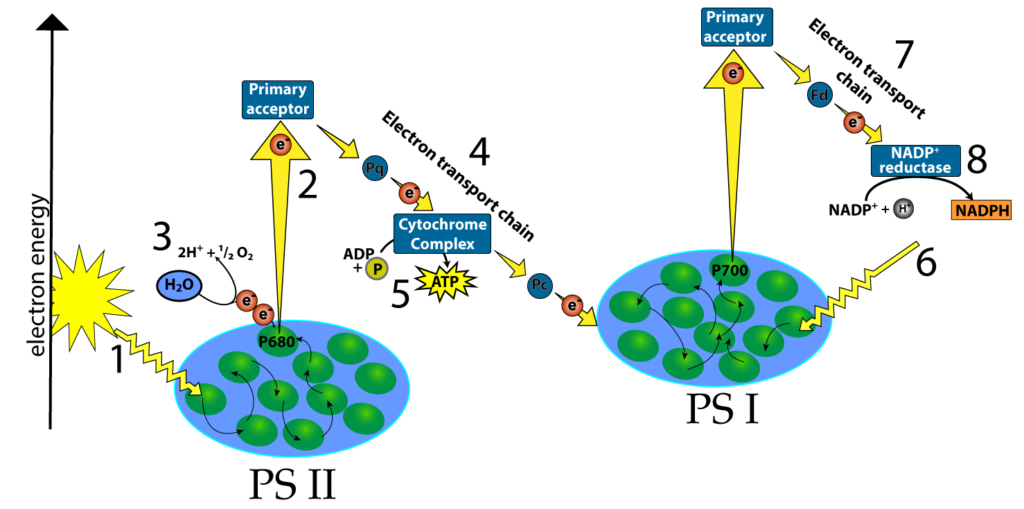
As with the diagram above, we’ll create a linear sequence, even though many parts of the process occur simultaneously. Notice that the Z scheme diagram has a Y-axis, which is electron energy.
- A photon arrives at Photosystem II. The energy from this photon bounces around the photosystem until it reaches the reaction center at P680.
- An electron in a chlorophyll molecule gets an energy boost that sends it to PS II’s primary electron acceptor. Note that in this diagram, the higher position of the electron at PS II’s primary acceptor means that it has more energy than the original electrons in the unenergized chlorophyll in PS II.
- As the PS II’s primary electron acceptor accepts chlorophyll’s electron (oxidizing it), an oxygen-evolving complex in PS II rips electrons away from a water molecule and passes them to p680. The water dissociates into protons and oxygen.
- PS II’s primary electron acceptor passes this energized electron to an electron transport chain. As the electron moves from one embedded electron carrier in the chain to the next, it releases energy.
- This energy release shown in step 4 is coupled with cellular work: in this case the work of creating ATP from ADP and Pi. (Note: we know how this happens: proton pumping, proton accumulation, and diffusion through ATP synthase. But because the Z scheme is about following the electrons, none of that is in the diagram).
- The electron from PS II arrives at PS I in a low energy condition. But, as it’s been traveling, photons have been shining on PS1, and energizing its electrons. The energy bounces to P700, and its electrons are boosted in energy and then snatched away by PS I’s primary electron acceptor. These lost electrons are replaced by the electrons arriving from PS II (which can ultimately be traced to water). Notice that the electron boost from PS I boosts these electrons to their highest energy level.
- PS I’s primary electron acceptor passes its energized electrons to PS 1’s electron transport chain. This ETC, however, doesn’t pump protons. Instead, it channels PS I’s high energy electrons to the enzyme NADP+ reductase.
- NADP+ reductase uses the incoming electron’s energy to convert oxidized, low-energy NADP+ into high energy, reduced NADPH.
6. The Z-scheme: Checking Understanding
Note again that this quiz includes some big diagrams. You might have to adjust the display on your screen (Ctrl – on Windows, Command – on Mac) for them to fit on your screen).
[qwiz style=”width: 800px;” random = “true” qrecord_id=”sciencemusicvideosMeister1961-PSN: The Z-Scheme”]
[h]The Z Scheme
[i]
[q labels = “top” dataset_id=”SMV_PSN_The Z scheme|28077b033a49f” question_number=”1″]
[l]electron transport chain
[fx] No, that’s not correct. Please try again.
[f*] Great!
[l]light
[fx] No. Please try again.
[f*] Good!
[l]Photosystem I
[fx] No, that’s not correct. Please try again.
[f*] Great!
[l]Photosystem II
[fx] No, that’s not correct. Please try again.
[f*] Great!
[l]splitting water
[fx] No, that’s not correct. Please try again.
[f*] Great!
[l]primary electron acceptor
[fx] No. Please try again.
[f*] Excellent!
[l]NADP+ reductase
[fx] No. Please try again.
[f*] Great!
[l]NADPH
[fx] No, that’s not correct. Please try again.
[f*] Good!
[q dataset_id=”SMV_PSN_The Z scheme|280113e28749f” question_number=”2″]In the diagram below, PS I is at
[textentry single_char=”true”]
[c]bw ==[Qq]
[f]WWVzLiBMZXR0ZXIg4oCcb+KAnSBpcyBQUyBJLg==[Qq]
[c]Kg==[Qq]
[f]Tm8uIFRoZSBwaG90b3N5c3RlbXMgaW5jbHVkZSB0aGUgY2hsb3JvcGh5bGwsIHRoZSBwcmltYXJ5IGFjY2VwdG9ycywgYW5kIHNvIG9uLiBJbiBhZGRpdGlvbiwgcmVtZW1iZXIgdGhhdCBpbiB0ZXJtcyBvZiBlbGVjdHJvbiBmbG93LCDCoFBTIDEgY29tZXMgYWZ0ZXI=IFBTIElJLg==
Cg==[Qq]
[q dataset_id=”SMV_PSN_The Z scheme|27faacc1d449f” question_number=”3″]In the diagram below, the primary electron acceptor for PS II is at
[textentry single_char=”true”]
[c]ZQ ==[Qq]
[f]WWVzLiBMZXR0ZXIg4oCcZeKAnSBpcyB0aGUgcHJpbWFyeSBlbGVjdHJvbiBhY2NlcHRvciBmb3IgUFMgSUku[Qq]
[c]Kg==[Qq]
[f]Tm8uIExvb2sgZm9yIHRoZSBpbml0aWFsICYjODIyMDtkZXN0aW5hdGlvbiYjODIyMTsgb2YgYW4gZWxlY3Ryb24gdGhhdCYjODIxNztzIGJlZW4gYm9vc3RlZCBieSBsaWdodCBlbmVyZ3kgaW4gUFMgSUkgKHdoaWNoLCBpbiB0ZXJtcyBvZiBlbGVjdHJvbiBmbG93LCBjb21lcyBiZWZvcmUgUFMgSSku
Cg==[Qq]
[q dataset_id=”SMV_PSN_The Z scheme|27f420606309f” question_number=”4″]In the diagram below, the electron transport chain that provides the energy for making ATP is
[textentry single_char=”true”]
[c]Zg ==[Qq]
[f]QXdlc29tZS4gTGV0dGVyIOKAnGbigJ0gaXMgdGhlIGVsZWN0cm9uIHRyYW5zcG9ydCBjaGFpbiB0aGF0IHByb3ZpZGVzIHRoZSBlbmVyZ3kgdG8gY29udmVydCBBRFAgYW5kIFAgaW50byBBVFAu[Qq]
[c]Kg==[Qq]
[f]Tm8uIFRyeSB0byBmaW5kIHRoZSBlbGVjdHJvbiB0cmFuc3BvcnQgY2hhaW4gdGhhdCBjb25uZWN0cyBQaG90b3N5c3RlbSBJSSB3aXRoIFBob3Rvc3lzdGVtIEku
Cg==[Qq]
[q dataset_id=”SMV_PSN_The Z scheme|27ecfefbf8c9f” question_number=”5″]In the diagram below, NADP+ reductase is
[textentry single_char=”true”]
[c]bA ==[Qq]
[f]QXdlc29tZS4gTGV0dGVyIOKAnGzigJ0gaXMgTkFEUA==Kw==IHJlZHVjdGFzZS4=[Qq]
[c]Kg==[Qq]
[f]Tm8uIEhlcmUmIzgyMTc7cyBhIGhpbnQuIFlvdSYjODIxNztsbCBmaW5kIE5BRFA=Kw==IHJlZHVjdGFzZSBhdCB0aGUgZW5kIG9mIHRoZSBlbGVjdHJvbiB0cmFuc3BvcnQgY2hhaW4gYXNzb2NpYXRlZCB3aXRoIFBob3Rvc3lzdGVtIEku[Qq]
[x][restart]
[/qwiz]
7. Cyclic Electron Flow Creates ATP without splitting water or generating NADPH
The term “non-cyclic electron flow” – the Z-scheme’s zig-zag flow of electrons from water to NADP+ – only makes sense if there is a non-linear, cyclical alternative. There is. In cyclic electron flow, a proton gradient is created for ATP synthesis, but there is no splitting of water, no production of oxygen, and no reduction of NADP+ to NADPH.
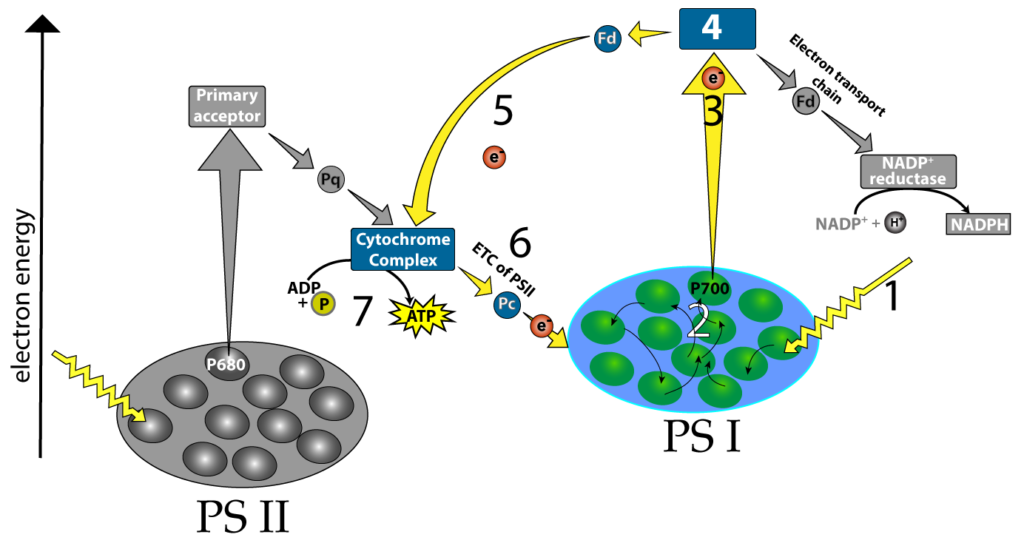
The big idea about cyclic electron flow is that it combines Photosystem I’s light-trapping machinery with Photosystem II’s electron transport chain. Here’s how it works. Light shining on Photosystem I (number “1” at left), excites electrons, which bounce around the photosystem (represented by “2”) until they reach reaction center p700. P700’s electrons are boosted to a higher energy level (at “3”), and then snatched up by Photosystem I’s primary electron acceptor (at “4”). So far, nothing new. But in cyclic electron flow, instead of electrons flowing to the right, to NADP+ reductase, they flow to the left, to the electron transport chain of Photosystem II (note that right and left only make sense in the context of the diagrams you’ve been looking at). As you can see above, electrons follow what’s called a “shunt pathway” (“5”) that brings them to the electron transport chain of photosystem II (“6”). The flow of energized electrons down this electron transport chain powers proton pumps (not shown in this diagram), which generates the electrochemical gradient that powers ATP synthesis (“7”).
The process is called cyclic because, at the end of the electron transport chain, the electrons return to photosystem I. This returns electrons to p700, which had become oxidized between steps “2” and “3.” So, no new electrons are required to enter the cycle (hence, no splitting of water, and no production of oxygen).
What causes this shunt pathway to occur? As we’ll see in the next tutorial, as the Calvin cycle transforms carbon dioxide into sugar, it uses three units of ATP for every two units of NADPH. If NADPH were to build up in the stroma, it would act as a competitive inhibitor for NADP+ reductase. In other words, with so much of the product (NADPH) around, it would be hard for the substrate (NADP+) to get access to NADP+ reductase’s active site. With electrons unable to flow to NADP+, they’d be forced to turn the other direction (left, instead of right, in the diagram above), which takes them down the shunt pathway. Because the shunt pathway fills the cytochrome complex in the electron transport chain with electrons, Photosystem II shuts down (because it has nowhere to send its electrons to). When NADPH starts to be consumed by the Calvin cycle, electrons once again start to flow to NADP+, and Photosystem II can start up again.
A final point about cyclic electron flow is this: don’t think of it as a weird exception to “normal” non-cyclic electron flow. There’s an entire category of bacteria known as photoheterotrophs whose photosynthetic repertoire consists solely of cyclic electron flow. In other words, these organisms only use photosynthesis to create ATP (through cyclic flow): they get their carbon by absorbing it from the environment. Additionally, it’s possible that cyclic electron flow was the first type of photosynthesis to evolve, and that the water-splitting, oxygen-producing, carbon dioxide-reducing photosynthesis that we see in chloroplasts is an evolutionary elaboration of this first photosynthetic pathway.
8. Cyclic Electron Flow: Interactive Diagram
Got it? Label the diagram below.
[qwiz qrecord_id=”sciencemusicvideosMeister1961-PSN: Cyclic Electron Flow, Interactive Diagram”]
[h]Interactive diagram: Cyclic electron flow
[q labels = “top”]
[l]ATP
[fx] No. Please try again.
[f*] Correct!
[l]boosted electron
[fx] No, that’s not correct. Please try again.
[f*] Excellent!
[l]light energy
[fx] No, that’s not correct. Please try again.
[f*] Good!
[l]NADP+ Reductase
[fx] No, that’s not correct. Please try again.
[f*] Excellent!
[l]primary electron acceptor
[fx] No, that’s not correct. Please try again.
[f*] Correct!
[l]PS II (inactive)
[fx] No, that’s not correct. Please try again.
[f*] Excellent!
[l]PS I
[fx] No, that’s not correct. Please try again.
[f*] Correct!
[l]shunt pathway
[fx] No, that’s not correct. Please try again.
[f*] Great!
[l]shut down ETC
[fx] No. Please try again.
[f*] Great!
[l]working ETC
[fx] No. Please try again.
[f*] Excellent!
[/qwiz]
9. Quiz: The Light Reactions
Okay! We’ve covered a lot of material above. Take the following quiz so you can consolidate what you’ve learned.
[qwiz style=”width: 800px !important;” random = “true” qrecord_id=”sciencemusicvideosMeister1961-PSN: The Light Reactions”]
[h]Cumulative Quiz: The Light Reactions
[i]
[q dataset_id=”SMV_PSN_Light Reactions Cumulative|27b771ea7cc9f” question_number=”1″] Which number or letter indicates the thylakoid membrane?
[textentry single_char=”true”]
[c]IG 8=[Qq]
[f]IFllcy4g4oCcb+KAnSBpcyB0aGUgdGh5bGFrb2lkIG1lbWJyYW5lLg==[Qq]
[c]ICo=[Qq]
[f]IE5vLiBIZXJlJiM4MjE3O3MgYSBoaW50LiBNZW1icmFuZXMgYXJlIG1hZGUgb2YgcGhvc3Bob2xpcGlkcyBhbmQgcHJvdGVpbnMuIFRoZSBwaG9zcGhvbGlwaWRzIGFyZSBvcmdhbml6ZWQgaW50byBhIGJpbGF5ZXIgKHR3byBsYXllcnMpLiBXaGF0IGxvb2tzIGxpa2UgaXQgY291bGQgYmUgYXJyYW5nZWQgaW4gdHdvIGxheWVycz8=
Cg==[Qq]
[q dataset_id=”SMV_PSN_Light Reactions Cumulative|27b1300a8809f” question_number=”2″] Which number or letter shows the oxidation of chlorophyll in Photosystem II?
[textentry single_char=”true”]
[c]IG w=[Qq]
[f]IFllcy4gTGV0dGVyIOKAnGzigJ0gc2hvd3MgdGhlIG94aWRhdGlvbiBvZiBjaGxvcm9waHlsbCBpbiBQaG90b3N5c3RlbSAyLg==[Qq]
[c]ICo=[Qq]
[f]IE5vLiBIZXJlJiM4MjE3O3MgYSBoaW50LiBGaW5kIFBob3Rvc3lzdGVtIDIuIFRoZW4gZmluZCBhbiBhcnJvdyBtb3ZpbmcgZnJvbSBjaGxvcm9waHlsbCBpbiB0aGUgcmVhY3Rpb24gY2VudGVyIHRvIGEgcHJpbWFyeSBlbGVjdHJvbiBhY2NlcHRvcg==
Cg==[Qq]
[q dataset_id=”SMV_PSN_Light Reactions Cumulative|27ab832d8c49f” question_number=”3″] Which number or letter indicates the electron transport chain that powers proton pumping from the stroma to the thylakoid space?
[textentry single_char=”true”]
[c]IG I=[Qq]
[f]IFllcy4gTGV0dGVyIOKAnGLigJ0gc2hvd3MgdGhlIGVsZWN0cm9uIHRyYW5zcG9ydCBjaGFpbiB0aGF0IHBvd2VycyB0aGUgcHVtcGluZyBvZiBwcm90b25zIGZyb20gdGhlIHN0cm9tYSB0byB0aGUgdGh5bGFrb2lkIHNwYWNlLg==[Qq]
[c]ICo=[Qq]
[f]IE5vLiBIZXJlJiM4MjE3O3MgYSBoaW50LiBMb29rIGZvciBhbiBhcnJvdyB0aGF0IHNob3dzIGEgcHJvdG9uIChIKw==KSBtb3ZpbmcgZnJvbSB0aGUgc3Ryb21hICgxKSB0byB0aGUgdGh5bGFrb2lkIHNwYWNlICgyKS4gTm93IGZpbmQgdGhlIGFycm93IHRoYXQgaW5kaWNhdGVzIHRoZSBlbGVjdHJvbiBmbG93IHRoYXQgcG93ZXJzIHRoYXQgcHVtcC4=
Cg==[Qq]
[q dataset_id=”SMV_PSN_Light Reactions Cumulative|27a58bcf1409f” question_number=”4″] Which number or letter indicates the pumping of protons from the stroma to the thylakoid space?
[textentry single_char=”true”]
[c]IG M=[Qq]
[f]IFllcy4gTGV0dGVyIOKAnGPigJ0gc2hvd3MgdGhlIHB1bXBpbmcgb2YgcHJvdG9ucyBmcm9tIHRoZSBzdHJvbWEgKDEpIHRvIHRoZSB0aHlsYWtvaWQgc3BhY2UgKDIp[Qq]
[c]ICo=[Qq]
[f]IE5vLiBIZXJlJiM4MjE3O3MgYSBoaW50LiBMb29rIGZvciBhbiBhcnJvdyB0aGF0IHNob3dzIGEgcHJvdG9uIChIKw==KSBtb3ZpbmcgZnJvbSB0aGUgc3Ryb21hICgxKSB0byB0aGUgdGh5bGFrb2lkIHNwYWNlICgyKS4=
Cg==[Qq]
[q dataset_id=”SMV_PSN_Light Reactions Cumulative|279fb9b15a09f” question_number=”5″] Which number or letter indicates the enzyme-catalyzed creation of the reduced, mobile electron carrier that brings reducing power to the Calvin cycle.
[textentry single_char=”true”]
[c]IG c=[Qq]
[f]IFllcy4gTGV0dGVyIOKAnGfigJ0gc2hvd3MgdGhlIGVuenltZSBOQURQKw==IHJlZHVjdGFzZSBjb252ZXJ0aW5nIE5BRFA=Kw==IHRvIE5BRFBILg==[Qq]
[c]ICo=[Qq]
[f]IE5vLiBIZXJlJiM4MjE3O3MgYSBoaW50LiBMb29rIGZvciBhIG1vbGVjdWxlIHRoYXQmIzgyMTc7cyBhY2NlcHRpbmcgYW4gZWxlY3Ryb24gKGFuZCBhIHByb3RvbiksIGNvbnZlcnRpbmcgaXQgaW50byBvbmUgb2YgdGhlIHR3byBrZXkgb3V0cHV0cyBvZiB0aGUgbGlnaHQgcmVhY3Rpb25zLg==
Cg==[Qq]
[q dataset_id=”SMV_PSN_Light Reactions Cumulative|2799e793a009f” question_number=”6″] Which number or letter indicates the accumulation of protons that powers the synthesis of ATP?
[textentry single_char=”true”]
[c]IG o=[Qq]
[f]IFllcy4gTGV0dGVyIOKAnGrigJ0gc2hvd3MgcHJvdG9uIGJ1aWxkdXAgaW5zaWRlIHRoZSB0aHlsYWtvaWQgc3BhY2UgZnJvbSB0aGUgc3BsaXR0aW5nIG9mIHdhdGVyICgmIzgyMjA7ayYjODIyMTspIGFuZCBwcm90b24gcHVtcGluZyBieSBwaG90b3N5c3RlbSAyJiM4MjE3O3MgZWxlY3Ryb24gdHJhbnNwb3J0IGNoYWluICgmIzgyMjA7YyYjODIyMTsp[Qq]
[c]ICo=[Qq]
[f]IE5vLiBIZXJlJiM4MjE3O3MgYSBoaW50LiBMb29rIGZvciBhbiBhcnJvdyBvciByZWdpb24gaW4gdGhlIGRpYWdyYW0gdGhhdCBzaG93cyB0aGUgYWNjdW11bGF0aW9uIG9mIHByb3RvbnMgZnJvbSB0aGUgc3BsaXR0aW5nIG9mIHdhdGVyLCBhbmQgZnJvbSB0aGUgcHVtcGluZyBvZiBwcm90b25zICh3aGljaCBpcyBzaG93biBhdCAmIzgyMjA7YyYjODIyMTspLg==
Cg==[Qq]
[q dataset_id=”SMV_PSN_Light Reactions Cumulative|2793caf46989f” question_number=”7″] Which number or letter indicates the reaction that’s the source of all of the oxygen in our atmosphere?
[textentry single_char=”true”]
[c]IG s=[Qq]
[f]IFllcy4gTGV0dGVyIOKAnGvigJ0gc2hvd3MgdGhlIHNwbGl0dGluZyBvZiB3YXRlciAoJiM4MjIwO2smIzgyMjE7KSwgd2hpY2ggcmVzdWx0cyBpbiBwcm90b25zLCBlbGVjdHJvbnMgKHdoaWNoIGdldCB1c2VkIGluIHBob3Rvc3ludGhlc2lzKSwgYW5kIG94eWdlbiAod2hpY2ggYnViYmxlcyBvdXQgb2YgdGhlIGNobG9yb3BsYXN0IGFuZCBpbnRvIG91ciBhdG1vc3BoZXJlKQ==[Qq]
[c]ICo=[Qq]
[f]IE5vLiBIZXJlJiM4MjE3O3MgYSBoaW50LiBMb29rIGZvciBhbiBhcnJvdyBvciByZWdpb24gaW4gdGhlIGRpYWdyYW0gdGhhdCBzaG93cyB0aGUgcHJvZHVjdGlvbiBvZiBveHlnZW4gKE8=Mg==KQ==
Cg==[Qq]
[q dataset_id=”SMV_PSN_Light Reactions Cumulative|278df8d6af89f” question_number=”8″] Which number or letter indicates the region of the chloroplast that would have a very low pH?
[textentry single_char=”true”]
[c]ID I=[Qq]
[f]IFllcy4gTGV0dGVyIOKAnDLigJ0gaW5kaWNhdGVzIHRoZSB0aHlsYWtvaWQgc3BhY2UuIEJlY2F1c2UgcHJvdG9ucyBhcmUgYmVpbmcgcHVtcGVkIGludG8gdGhpcyByZWdpb24sIGl0IHdpbGwgaGF2ZSBhIGxvdyBwSCAoYmVjYXVzZSBsb3cgcEggbWVhbnMgaGlnaCBwcm90b24gY29uY2VudHJhdGlvbiku[Qq]
[c]ICo=[Qq]
[f]IE5vLiBIZXJlJiM4MjE3O3MgYSBoaW50LiBMb29rIGZvciB0aGUgcmVnaW9uIHdoZXJlIHByb3RvbnMgYXJlIGFjY3VtdWxhdGluZy7CoEJlY2F1c2UgcHJvdG9ucyBhcmUgYmVpbmcgcHVtcGVkIGludG8gdGhpcyByZWdpb24sIGl0IHdpbGwgaGF2ZSBhIGxvdyBwSCAoYmVjYXVzZSBsb3cgcEggbWVhbnMgaGlnaCBwcm90b24gY29uY2VudHJhdGlvbiku
Cg==[Qq]
[q dataset_id=”SMV_PSN_Light Reactions Cumulative|27884bf9b3c9f” question_number=”9″] Which number or letter indicates the primary electron acceptor of Photosystem I?
[textentry single_char=”true”]
[c]IG k=[Qq]
[f]IFllcy4gVGhlIGxldHRlciDigJxp4oCdIGluZGljYXRlcyB0aGUgcHJpbWFyeSBlbGVjdHJvbiBhY2NlcHRvciBvZiBQaG90b3N5c3RlbSAxLg==[Qq]
[c]ICo=[Qq]
[f]IE5vLiBIZXJlJiM4MjE3O3MgYSBoaW50LiBGaWd1cmUgb3V0IHdoaWNoIHBob3Rvc3lzdGVtIGlzIFBob3Rvc3lzdGVtIDEuIFRoZW4gZmluZCB0aGUgcG9pbnQgaW4gdGhhdCBzeXN0ZW0gd2hlcmUgZWxlY3Ryb25zIGhhdmUgdGhlaXIgaGlnaGVzdCBlbmVyZ3kgbGV2ZWwu
Cg==[Qq]
[q dataset_id=”SMV_PSN_Light Reactions Cumulative|27829f1cb809f” question_number=”10″] Which letter indicates the source of all of the electrons involved in the light reactions of photosynthesis?
[textentry single_char=”true”]
[c]IG Q=[Qq]
[f]IFllcy4gTGV0dGVyIOKAnGTigJ0gaW5kaWNhdGVzIHdhdGVyLCB3aGljaCBpcyB0aGUgc291cmNlIG9mIGFsbCBvZiB0aGUgZWxlY3Ryb25zIGludm9sdmVkIGluIHRoZSBsaWdodCByZWFjdGlvbnMu[Qq]
[c]ICo=[Qq]
[f]IE5vLiBIZXJlJiM4MjE3O3MgYSBoaW50LiBXb3JrIGJhY2t3YXJkIHRvIGZpbmQgdGhlIGZpcnN0IGVsZWN0cm9ucyB0aGF0IGdldCBib29zdGVkIGJ5IGxpZ2h0IGluIFBob3Rvc3lzdGVtIElJLiBXaGVyZSBhcmUgdGhvc2UgZWxlY3Ryb25zIGNvbWluZyBmcm9tPw==
Cg==[Qq]
[q dataset_id=”SMV_PSN_Light Reactions Cumulative|277cf23fbc49f” question_number=”11″] Which letter indicates the reaction center for Photosystem II?
[textentry single_char=”true”]
[c]IG M=[Qq]
[f]IFllcy4gTGV0dGVyIOKAnGPigJ0gaW5kaWNhdGVzIHA2ODAsIHdoaWNoIGlzIHBob3Rvc3lzdGVtIElJJiM4MjE3O3MgcmVhY3Rpb24gY2VudGVyLg==[Qq]
[c]ICo=[Qq]
[f]IE5vLiBIZXJlJiM4MjE3O3MgYSBoaW50LiBGaW5kIFBob3Rvc3lzdGVtIElJLiBOb3cgZmluZCB0aGUgbGFzdCBjaGxvcm9waHlsbCBtb2xlY3VsZSB0aGF0JiM4MjE3O3MgaW4gdGhlIGNoYWluIG9mIGVuZXJneSB0cmFuc2ZlcnMgdGhhdCBsZWFkcyB0byBlbGVjdHJvbnMgYmVpbmcgdHJhbnNmZXJyZWQgdG8gYSBwcmltYXJ5IGVsZWN0cm9uIGFjY2VwdG9yLg==
Cg==[Qq]
[q dataset_id=”SMV_PSN_Light Reactions Cumulative|27774562c089f” question_number=”12″] Which letter indicates ATP?
[textentry single_char=”true”]
[c]IG g=[Qq]
[f]IFllcy4gTGV0dGVyIOKAnGjigJ0gaW5kaWNhdGVzIEFUUA==[Qq]
[c]ICo=[Qq]
[f]IE5vLiBIZXJlJiM4MjE3O3MgYSBoaW50LiBBVFAgc3ludGhlc2lzIGlzIHBvd2VyZWQgYnkgdGhlIGVsZWN0cm9uIHRyYW5zcG9ydCBjaGFpbiB0aGF0IGJyaW5ncyBlbGVjdHJvbnMgZnJvbSBQaG90b3N5c3RlbSBJSSB0byBQaG90b3N5c3RlbSBJLg==
Cg==[Qq]
[q dataset_id=”SMV_PSN_Light Reactions Cumulative|2771e3074149f” question_number=”13″] Collectively, these pigment molecules make up an antenna complex.
[textentry single_char=”true”]
[c]ID M=[Qq]
[f]IFllcy4gVGhlIGNobG9yb3BoeWxsIG1vbGVjdWxlcyBpbmRpY2F0ZWQgYnkgJiM4MjIwOzMmIzgyMjE7IG1ha2UgdXAgdGhlIGFudGVubmEgY29tcGxleC4=[Qq]
[c]ICo=[Qq]
[f]IE5vLiBIZXJlJiM4MjE3O3MgYSBoaW50LiBUaGUgcGlnbWVudCBtb2xlY3VsZXMgcmVmZXJyZWQgdG8gaW4gdGhlIHF1ZXN0aW9uIGFyZSBjaGxvcm9waHlsbCBtb2xlY3VsZXMuIFdoYXQgY29sb3IgaXMgY2hsb3JvcGh5bGw/
Cg==[Qq]
[q dataset_id=”SMV_PSN_Light Reactions Cumulative|276ca5ec8049f” question_number=”14″] During the light reactions, protons get pumped into this space.
[textentry single_char=”true”]
[c]ID U=[Qq]
[f]IFllcy4gRHVyaW5nIHRoZSBsaWdodCByZWFjdGlvbnMsIHByb3RvbnMgYXJlIHB1bXBlZCBmcm9tIHRoZSBzdHJvbWEgdG8gdGhlIHRoeWxha29pZCBzcGFjZSAoYXQgJiM4MjIwOzUuJiM4MjIxOyk=[Qq]
[c]ICo=[Qq]
[f]IE5vLiBIZXJlJiM4MjE3O3MgYSBoaW50LiBUaGUgcHVtcGluZyBvZiBwcm90b25zIGFzc29jaWF0ZWQgd2l0aCBBVFAgc3ludGhlc2lzIGFsd2F5cyBpbnZvbHZlcyBwdW1waW5nIHRoZW0gaW50byBhbiBlbmNsb3NlZCBzcGFjZS4gV2hhdCB0aW55IGVuY2xvc2VkIHNwYWNlcyBhcmUgc2hvd24gb24gdGhpcyBkaWFncmFtPw==
Cg==[Qq]
[q dataset_id=”SMV_PSN_Light Reactions Cumulative|27671e5042c9f” question_number=”15″] The pH of this fluid is significantly higher (less acidic) than the pH in the thylakoid space.
[textentry single_char=”true”]
[c]ID Y=[Qq]
[f]IFllcy4gRHVyaW5nIHRoZSBsaWdodCByZWFjdGlvbnMsIHByb3RvbnMgYXJlIHB1bXBlZCBmcm9tIHRoZSBzdHJvbWEgdG8gdGhlIHRoeWxha29pZCBzcGFjZSAoYXQgJiM4MjIwOzUuJiM4MjIxOykgVGhpcyBsb3dlcnMgdGhlIHBIIGluIHRoZSB0aHlsYWtvaWQgc3BhY2UsIGFuZCByYWlzZXMgdGhlIHBIIGluIHRoZSBzdHJvbWEgKCYjODIyMDs2JiM4MjIxOyku[Qq]
[c]ICo=[Qq]
[f]IE5vLiBIZXJlJiM4MjE3O3MgYSBoaW50LiBUaGUgcHVtcGluZyBvZiBwcm90b25zIHRoYXQmIzgyMTc7cyBhc3NvY2lhdGVkIHdpdGggQVRQIHN5bnRoZXNpcyBtb3ZlcyBwcm90b25zIGludG8gdGhlIHRoeWxha29pZCBzcGFjZSAobG93ZXJpbmcgdGhlIHBIIHRoZXJlKSBhbmQgb3V0IG9mIHRoZSBzdHJvbWEsIChyYWlzaW5nIHRoZSBwSCB0aGVyZSku
Cg==[Qq]
[q dataset_id=”SMV_PSN_Light Reactions Cumulative|276206764009f” question_number=”16″] A by-product that results from the splitting of water that occurs during the light reactions
[textentry single_char=”true”]
[c]ID M=[Qq]
[f]IFllcy4gVGhlIHNwbGl0dGluZyBvZiB3YXRlciBjcmVhdGVzIG94eWdlbiAoJiM4MjIwOzMmIzgyMjE7KSB3aGljaCBpcyBhIGJ5LXByb2R1Y3Qgb2YgdGhlIGxpZ2h0IHJlYWN0aW9ucy4=[Qq]
[c]ICo=[Qq]
[f]IE5vLiBIZXJlJiM4MjE3O3MgYSBoaW50LiBCZWNhdXNlIHRoaXMgaXMgYSBieS1wcm9kdWN0LCBsb29rIGZvciBzb21ldGhpbmcgdGhhdCYjODIxNztzIGxlYXZpbmcgdGhlIGxpZ2h0IHJlYWN0aW9ucywgd2hpY2ggaXMgdGhlcmVmb3JlIG5vdCBjb250cmlidXRpbmcgdG8gdGhlIG5leHQgcGhhc2Ugb2YgcGhvdG9zeW50aGVzaXMgKHRoZSBDYWx2aW4gY3ljbGUpLg==
Cg==[Qq]
[q dataset_id=”SMV_PSN_Light Reactions Cumulative|275c7eda0289f” question_number=”17″] The source of the electrons in the light-powered electrical current that is part of the light reactions.
[textentry single_char=”true”]
[c]ID I=[Qq]
[f]IFllcy4gTnVtYmVyICYjODIyMDsyJiM4MjIxOyByZXByZXNlbnRzIHdhdGVyLCB0aGUgc291cmNlIG9mIHRoZSBlbGVjdHJvbnMgaW52b2x2ZWQgaW4gdGhlIGxpZ2h0IHJlYWN0aW9ucy4=[Qq]
[c]ICo=[Qq]
[f]IE5vLiBIZXJlJiM4MjE3O3MgYSBoaW50LiBMb29rIGZvciBhbiBpbnB1dCBvZiBtYXR0ZXIgKG5vdCBlbmVyZ3kpIHRvIHRoZSBsaWdodCByZWFjdGlvbnMgKHRoZXJlJiM4MjE3O3Mgb25seSBvbmUpLg==
Cg==IA==[Qq]
[q dataset_id=”SMV_PSN_Light Reactions Cumulative|2756877b8a49f” question_number=”18″] During the light reactions, the energy of electrons powers the pumping of[hangman]from the stroma to the thylakoid space.
[c]IHByb3RvbnM=
Cg==[Qq]
[q dataset_id=”SMV_PSN_Light Reactions Cumulative|2750ffdf4cc9f” question_number=”19″] The flow of protons from the thylakoid space to the stroma occurs through [hangman] diffusion.
[c]IGZhY2lsaXRhdGVk
Cg==[Qq]
[q dataset_id=”SMV_PSN_Light Reactions Cumulative|274b53025109f” question_number=”20″] In the light reactions, ATP is synthesized as protons diffuse through an ATP [hangman] channel.
[c]IHN5bnRoYXNl
Cg==[Qq]
[q dataset_id=”SMV_PSN_Light Reactions Cumulative|27463b284e49f” question_number=”21″] The pumping of protons from the stroma into the thylakoid space occurs through [hangman] transport.
[c]IGFjdGl2ZQ==
Cg==IA==[Qq]
[q dataset_id=”SMV_PSN_Light Reactions Cumulative|27408e4b5289f” question_number=”22″] The enzyme that converts NADP+ into NADPH is called NADP+ [hangman]
[c]IHJlZHVjdGFzZQ==
Cg==[Qq]
[q dataset_id=”SMV_PSN_Light Reactions Cumulative|e88da73b1b6f9″ question_number=”23″]The “shunt pathway” that brings electrons from photosystem I to photosystem I’s ETC is at
[textentry single_char=”true”]
[c]IG g=[Qq]
[f]IFllcy4gTGV0dGVyIOKAnGjigJ0gaW5kaWNhdGVzIHRoZSBzaHVudCBwYXRod2F5Lg==[Qq]
[c]ICo=[Qq]
[f]IE5vLiBIZXJlJiM4MjE3O3MgYSBoaW50LiBGaW5kIFBob3Rvc3lzdGVtIEkgKGF0ICYjODIyMDtlJiM4MjIxOykuIFdoaWNoIGFycm93IHNodW50cyBlbGVjdHJvbnMgZnJvbSB0aGlzIHBhdGh3YXkgb3ZlciB0byB0aGUgZWxlY3Ryb24gdHJhbnNwb3J0IGNoYWluIGZyb20gUGhvdG9zeXN0ZW0gSUk/
Cg==[Qq]
[q dataset_id=”SMV_PSN_Light Reactions Cumulative|1ca84927a6dfc4″ question_number=”24″]The diagram shown below is most likely demonstrating
[c]cHJvZHVjdGlvbiBvZiBveHlnZW4=[Qq]
[f]IE5vLiBCZWNhdXNlIFBob3Rvc3lzdGVtIElJIChhdCAmIzgyMjA7ZiYjODIyMTspIGlzIHNodXQgZG93biwgdGhlcmUmIzgyMTc7cyBubyBzcGxpdHRpbmcgb2Ygd2F0ZXIuIEhlcmUmIzgyMTc7cyBhIGhpbnQuIFN0YXJ0aW5nIGZyb20gJiM4MjIwO2osJiM4MjIxOyBub3RlIGhvdyB0aGUgZWxlY3Ryb25zIGFyZSBmbG93aW5nLg==[Qq]
[c]cmVkdWN0aW9uIG9mIE5BRFA=Kw==[Qq]
[f]IE5vLiBOb3RlIGhvdyB0aGUgcGF0aHdheSB0byBOQURQKw==IHJlZHVjdGFzZSAoYXQgJiM4MjIwO2MmIzgyMjE7KSBpcyBncmF5ZWQgb3V0LCBhbmQgaG93IHRoZXJlIGFyZSBubyBlbGVjdHJvbnMgZmxvd2luZyBpbiB0aGF0IGRpcmVjdGlvbi4gSGVyZSYjODIxNztzIGEgaGludC4gU3RhcnRpbmcgZnJvbSAmIzgyMjA7aiwmIzgyMjE7IG5vdGUgaG93IHRoZSBlbGVjdHJvbnMgYXJlIGZsb3dpbmcu[Qq]
[c]Y3ljbGljIGVsZW N0cm9uIGZsb3c=[Qq]
[f]RXhjZWxsZW50LiBUaGlzIGlzIGEgZGVwaWN0aW9uIG9mIGN5Y2xpYyBlbGVjdHJvbiBmbG93Lg==[Qq]
[c]bm9uLWN5Y2xpYyBlbGVjdHJvbiBmbG93[Qq]
[f]IE5vLiBMaW5lYXIgZWxlY3Ryb24gZmxvdyBzdGFydHMgd2l0aCB3YXRlciBhbmQgZW5kcyB3aXRoIE5BRFA=Kw==LiBIZXJlJiM4MjE3O3MgYSBoaW50LiBTdGFydGluZyBmcm9tICYjODIyMDtqLCYjODIyMTsgbm90ZSBob3cgdGhlIGVsZWN0cm9ucyBhcmUgZmxvd2luZy4=
Cg==[Qq]
[q dataset_id=”SMV_PSN_Light Reactions Cumulative|1ca7fc521e7bc4″ question_number=”25″]In the process shown below, the energy for ATP production is generated by
[textentry single_char=”true”]
[c]aw ==[Qq]
[f]IFllcy4gTGV0dGVyIOKAnGvigJ0gaW5kaWNhdGVzIHRoZSBlbGVjdHJvbiB0cmFuc3BvcnQgY2hhaW4gZnJvbSBQaG90b3N5c3RlbSBJSS4gVGhpcyBFVEMgdXNlcyBlbGVjdHJvbiBlbmVyZ3kgdG8gcHVtcCBwcm90b25zIGZyb20gdGhlIHN0cm9tYSB0byB0aGUgdGh5bGFrb2lkIHNwYWNlLCBhbmQgZGlmZnVzaW9uIG9mIHByb3RvbnMgZnJvbSB0aGF0IHNwYWNlIHRocm91Z2ggQVRQIHN5bnRoYXNlIGdlbmVyYXRlcyBBVFAu[Qq]
[c]ICo=[Qq]
[f]IE5vLiBIZXJlJiM4MjE3O3MgYSBoaW50LiBGaW5kIGFuIGVsZWN0cm9uIHRyYW5zcG9ydCBjaGFpbiB0aGF0IHNlZW1zIHRvIGJlIGFzc29jaWF0ZWQgd2l0aCBBVFAgcHJvZHVjdGlvbiwgd2hpY2ggaXMgaGFwcGVuaW5nIGF0IGxldHRlciAmIzgyMjA7Zy4mIzgyMjE7
Cg==[Qq]
[q dataset_id=”SMV_PSN_Light Reactions Cumulative|1ca7ad288a33c4″ question_number=”26″]The process below generates ATP but not [hangman].
[c]TkFEUEg=
Cg==[Qq]
[q dataset_id=”SMV_PSN_Light Reactions Cumulative|1ca72d19fc37c4″ question_number=”27″]The process below can be described as [hangman] electron flow.
[c]Y3ljbGlj[Qq]
[x][restart]
[/qwiz]
Links
- Photosynthesis 5: The Calvin Cycle (the next tutorial in this series)
- The Light Reactions: A Musical Interlude (music videos with interactive lyrics about the light reactions).
- Photosynthesis Main Menu

